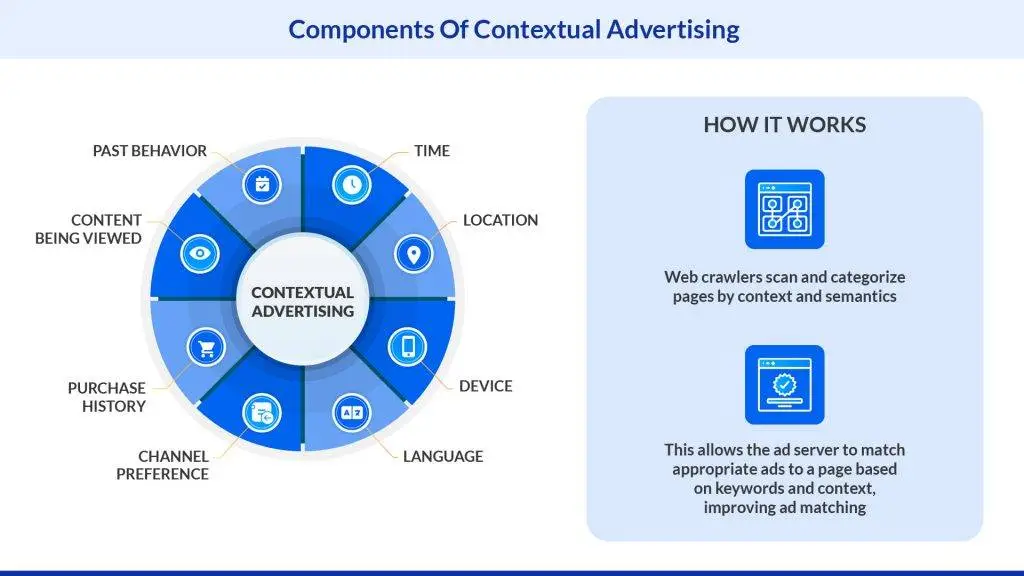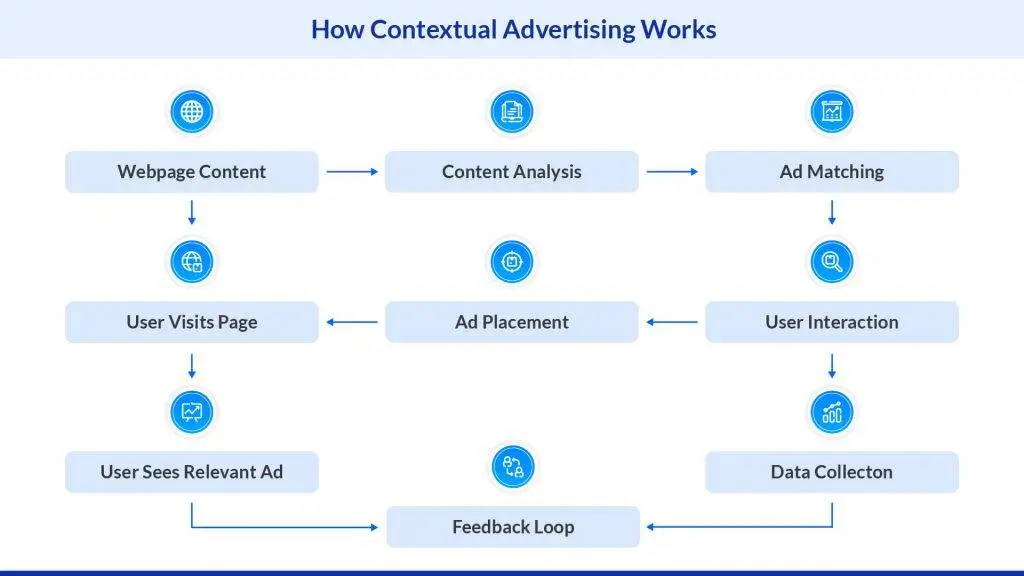Ready to transform window shoppers into paying customers?
Grabbing attention from users ready to make a purchase is like hitting the jackpot in the crowded internet marketplace. With thousands of ads bombarding people every day, it’s crucial to stand out when someone actively seeks to make a purchase. This is where product-specific ads come into play. These ads aren’t just about grabbing attention but also about being relevant at the right time and place. They give you an edge when it matters most by aligning with how customers search for products. Join us as we explore how to harness product-contextual advertisements to attract and convert customers.
What are product contextual advertisements?
Product contextual ads align your product promotions with the content of the webpage that potential customers are already engaged with. These ads guarantee visibility to the appropriate audience by leveraging the context of a user’s current website interaction.
How do they work?
Product contextual ads technology combines relevance and timing to display ads tailored to a user’s browsing history, search patterns, and purchase behavior. By strategically placing these ads, PCA (product contextual ads) targets users already in a decision-making mindset related to the advertised products. This approach sets ‘Product contextual ads’ apart from other advertising methods by focusing on reaching interested buyers rather than casting a wide net.
Ultimately, product contextual ads (PCA) effectively reach the target audience and boost brand revenue by ensuring that ads are shown to the right audience, increasing the likelihood of conversions and sales.
How does contextual targeting work?
Contextual targeting involves placing ads in a precise and intelligent way to ensure they are not only visible but also relevant and timely. This approach is based on the idea that an ad connected to the content of the web pages a user currently interacts with will be more impactful and less disruptive.
Contextual targeting’s power lies in its accuracy and benefits to advertisers and consumers. Advertisers can expect a greater ROI, as relevant ads are more likely to be clicked on, reaching an already engaged audience. On the other hand, consumers benefit from a more enjoyable user experience, with ads tailored to their interests, reducing ad fatigue and increasing engagement.

The mechanics of contextual targeting
Classification of content: Each web page in an advertising network undergoes categorization according to its content. Advanced machine learning algorithms scrutinize the text, images, video, and metadata to comprehensively understand the subject matter.
Extraction of keywords: The content of a web page is scanned for keywords, offering a concise overview of the web page. This process incorporates individual words, phrases and topics that enrich the context of the content.
Ad relevance matching: The ad network‘s database has a variety of ads tagged with similar keywords ensuring that the displayed ad is relevant to the content.
User experience enhancement: By matching ads to web page’s content, users receive recommendations for products and services that match their current interests. This makes their browsing experience more engaging.
Dynamic ad placement: As visitors explore the website, the contextual targeting system modifies ads in real-time, maintaining a high level of relevance no matter which page they visit.

What is the difference between PCA (product contextual ads) and PLA (product listing ads)?
Feature | Product Contextual Ads (PCA) | Product Listing Ads (PLA) |
Definition | Ads that align with the context of the website or content a user is currently viewing. | Ads that display product details in a specialized shopping section or in search engine results. |
Placement | Displayed on websites featuring content relevant to the product being advertised. | Typically found on search engine results pages or within shopping platforms such as Google Shopping. |
Trigger | Triggered by the relevance to the content or theme of the page. | Triggered by specific product searches made by users. |
Ad content | Common ad formats include banners, in-text ads, and video ads. | Typically contains a product description, price, and image; occasionally includes reviews or ratings as well. |
Targeting | Based on the context and content of websites. | Based on product queries and keywords. |
Cost Structure | Usually employs a cost-per-impression (CPM) or cost-per-click (CPC) model. | Typically uses a cost-per-click (CPC) model in which advertisers pay for each click that leads to their website or product page. |
Optimization | Optimized for relevance to content and user interest. | Optimized for product searches and buyer intent. |
Best Used For | Improving content and providing appropriate product recommendations. | Direct product promotion and sales when users are searching with high purchase intent. |
Measurement of Success | Engagement rates, click-through rates, and content relevance. | Click-through rates, conversion rates, and return on ad spend (ROAS) |
User Stage Targeted | Top to middle of the funnel – enhancing interest and relevance. | Bottom of the funnel – prospects ready to make a purchase. |
Why is context important in product advertising now more than ever?
In the past, behavioral advertising was a key part of digital marketing. It heavily depended on third-party data to track users’ past online activities and predict their future interests. However, it is facing increased scrutiny and resistance due to privacy concerns. With regulations like GDPR and CCPA imposing strict rules on data usage, the cookie method is becoming less effective in a privacy-focused world.
Meanwhile, behavioral targeting involves segmenting audiences based on demographics like age, gender, and income. This approach is often too general and fails to acknowledge user interests, user behaviors and their ever-changing nature. It overlooks the reality that people within the same demographic category can have vastly different preferences and motivations.
Contextual targeting is a great alternative to traditional marketing approaches. It uses first-party data and the user context to ensure that ads are relevant to the user’s interests rather than relying on outdated historical user data.
As consumer interests evolve, contextual advertising adjusts in real-time to accurately reflect user intent to maintain relevance and timing. Additionally, with third-party cookies becoming obsolete due to privacy laws, contextual advertising solutions are not just an option but a necessity. Companies are realizing the limitations of relying on restricted data collection methods, as they pose significant challenges in customer experience personalization.
Must Read: Why you should use retail media ads?
The powerful combination of retail media and contextual advertising
Retail media represents the core of contextual advertising, positioning ads in an online environment where purchase intent is already present. This approach guarantees a high level of relevance by showcasing ads with relevant content that actively engages the user.
Benefits of contextual advertising:
High relevance: Modern algorithms go beyond keyword matching to fully understand a page’s context, ensuring brand safety and relevance.
Cookie-less advertising: Rather than relying on stale third-party data, retail media’s power is in its capacity to target based on the context of the user’s current activity.
Improved customer experience: Since contextually relevant ads feel less intrusive and more in sync with users’ current interests, they are more likely to be accepted by users.
Things to consider while running contextual ads?
Keep user intent in mind
Users display different behaviors and search patterns depending on where they are in the buying cycle. For example, a user reading reviews is probably closer to purchasing than someone just starting their research.
Focusing on keywords and relevant content can help reach users in their decision-making process, potentially increasing ad engagement. The main goal is to understand and align with the user’s intent based on the content they are viewing.
Additional Read: What is Addressable Advertising and How It Works?
Focus on contextual keywords
In contrast to SEO, which focuses on ranking for traffic-driving keywords, contextual targeting involves placing ads in accurate contexts to ensure relevance. For example, a ketchup brand can appear alongside content related to grilling, BBQs, and summer events. This deliberate placement increases the likelihood of the ads being seen by an audience interested in the product. Additionally, incorporating branded keywords can enhance brand recognition and loyalty, which is especially beneficial for established brands.
Align your creatives with keywords
The design must complement the accompanying content. For example, a fitness app encouraging home workouts could feature an ad showing a person using the app on their phone while exercising in a small, comfortable living space. This visual would pair well with content about staying fit at home or making the most of limited exercise areas. The selected keyword targeting might include home workout apps, fitness in small spaces, and quick home exercises.
A/B testing could involve different designs targeting busy professionals at home versus stay-at-home parents to determine which demographic engages more with the ad. By testing these designs with the same set of keywords, the company can analyze which approach resonates more with their target audience and leads to increased engagement and sales. This data-driven strategy enables the company to optimize its advertising budget and messaging for the best possible return on investment.
Read More: Mastering Keyword Bidding: A Comprehensive Guide For Retail Businesses
Appropriately group your ad campaigns
Effective contextual advertising relies on segmentation as a core element. Advertisers can precisely refine their targeting and messaging by establishing distinct ad groups tailored to specific contexts.
This approach guarantees that the advertisements are relevant to the intended audience and evaluates the most successful strategies. Performance assessment can be conducted based on scope, business influence, and inventory accessibility, streamlining resource allocation towards the most impactful campaigns.
Combine PCA with PCL ads
Combining Product Category Ads (PCA) with Product Listing Ads (PLA) can be a highly effective approach. PCA focuses on attracting users with general interests at the category level, while PCL targets users closer to making a specific purchase.
This pairing allows for a broad yet focused outreach, engaging users exploring a category and those seeking particular products.
Track and optimize your PCA campaign
The key to a successful ad campaign lies in consistent monitoring and fine-tuning. For product contextual ads, this involves closely tracking the most effective contexts and placements and adjusting bids, creatives, and targeting accordingly.
This process also includes conversion tracking, A/B testing of landing pages, and refining ad copy. By remaining adaptable and attentive to performance data, you can progressively enhance your PCA campaigns to ensure they connect with the audience and achieve desired results.
Conclusion
FCC Product Contextual Ads (PCA) provides a great way for brands to engage with their desired audience during the customer’s buying journey. By utilizing Flipkart’s extensive user base and advanced targeting algorithms, advertisers can achieve high visibility, broad reach and performance, ensuring their products are presented to the most suitable customers.
The platform’s cost-efficient CPC bidding model, time-saving auto-creative feature, and self-service capabilities make it an appealing choice for brands seeking to enhance their e-commerce marketing approach. FCC stands out with its user-friendly design, allowing marketers to easily create, manage, and optimize their ad campaigns. It offers a marketplace where relevance meets reach, enabling strategic brand placements that drive awareness and conversion.